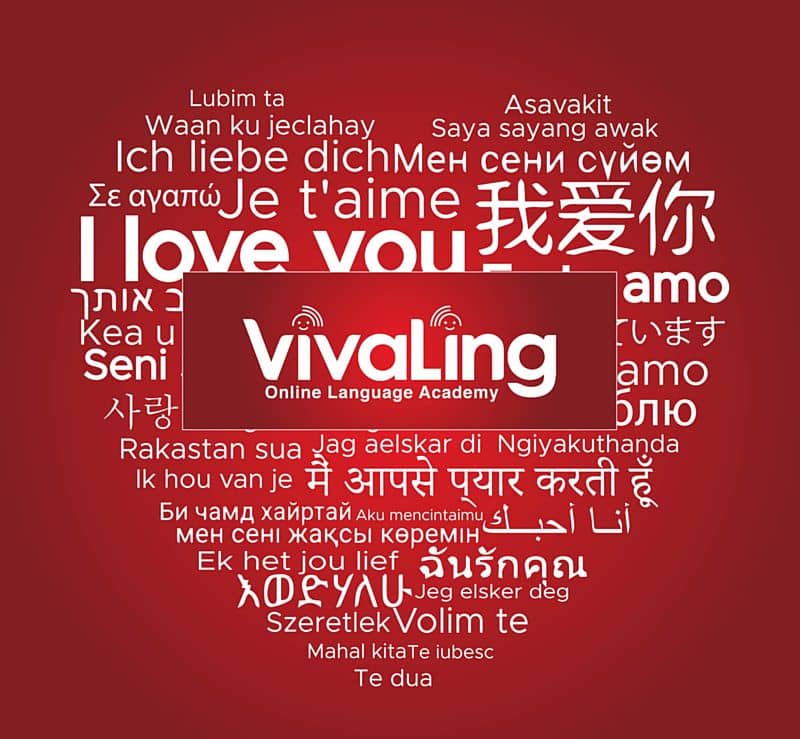A passionate relation
Since it is Valentine’s month, we are going to explore the relationship between love and languages, from the most obvious to the most subtle. This is an opportunity to make an important point: the love of languages is undoubtedly what unites us all at VivaLing.
But what about love in languages, or even the language of love?
We will start our love saga in the Middle Ages with the birth of the word romance, then cross all the eras to tackle the most modern forms of love expression through languages.
The chivalrous origins of romance
The story of the word ‘romance’ begins as the fifth century draws to a close, and the Roman Empire with it. The main actors in the story are the inhabitants of Gaul, a region comprising present-day France and parts of Belgium, West Germany and Northern Italy. The Gauls spoke a language derived from Latin, which we now call Gallo-Roman, but which the Gauls themselves called Romanus, from the Latin word for ‘Rome’ or ‘Roman’.
At the end of the century, a Latin adverb Romanice, derived from Romanus, appears with the meaning of “in the vernacular”, alluding to the languages derived from Gallo-Romance, namely Old French and Old Occitan. In Old French, the Latin romanice is adapted into romans or romanz. The new word is a noun, and it refers not only to Old French itself, but also to works composed in that language.

This is the Middle Ages, and the romances composed are often stories written in verse and relating to – what else? – the affections and adventures of gallant and honourable knights. Romances take on a meaning that refers specifically to metrical treatments of love and knightly times, and the fate of the word romance in modern English is sealed: its close association with love narratives binds it forever to love affairs, whether true or merely dreamt.
Valentine’s Day, an original expression of romance
St. Valentine’s Day has its origins in several versions told by the Catholic Church, during the same period as the romance. The latter recognises at least three different saints named Valentine or Valentinus, all of whom were martyred.
One legend claims that Valentine was a priest who served in third-century Rome.
When Emperor Claudius II decided that single men made better soldiers than those with wives and families, he banned marriage for young men. Valentine, realising the injustice of the decree, defied Claudius and continued to perform marriages for young lovers in secret. When Valentinus’ actions were discovered, Claudius ordered that he be put to death. Still others insist that it is St. Valentine of Terni, a bishop, who is the true namesake of this festival. He too was beheaded by Claudius II outside Rome.
Other stories suggest that Valentine was killed for trying to help Christians escape the harsh Roman prisons, where they were often beaten and tortured. According to one legend, an imprisoned Valentine sent the first Valentine’s Day letter himself after falling in love with a young girl – probably his jailer’s daughter – who was visiting him in prison.
Before he died, he is said to have written her a letter signed “From your Valentine”, an expression that is still used today.
Although the truth behind the Valentine legends is obscure, the stories all emphasise his appeal as a sympathetic, heroic and, above all, romantic figure. In the Middle Ages, perhaps because of this reputation, Valentine became one of the most popular saints in England and France.

As we are sure you have learnt by now, Valentine’s Day as it is celebrated today is far from medieval rites and traditions!
It has become a form of modern and globalized romance, where almost every country on the planet expresses its feelings in its own way.
Modern variations of the celebration of love
The very first Valentine’s Day card is thought to have originated in France, when Charles, the Duke of Orleans, sent love letters to his wife from prison in 1415.
Although Valentine’s Day is now celebrated almost everywhere in the world, this language of love manifests itself in many different forms and on different dates, depending on where you live!
Having travelled back in time, we are now onboard a ship that will allow us to tour the world of romantic traditions in a few minutes!

Argentines do not celebrate Valentine’s Day in February, but the “week of sweetness” in July. This is the day when lovers exchange kisses and receive chocolates and other sweets.
In Wales, Valentine’s Day is celebrated in the most unusual way. The country celebrates its day of love on 25 January, which is called “San Dwynwen Day“. On this day, lovers exchange unique and beautifully handcrafted wooden spoons. This tradition has been practiced since the 16th century.
The Day of Love in Valencia, Spain, falls on 9 October, the feast day of Saint Dionysus. The festival is celebrated in most parts of Spain by making the “macadora“, a marzipan figurine. Men make these figures as gifts for their wives. Colourful parades can also be seen in the streets of Spanish villages.
In Miao, in southwest China, the “Sisters’ Meal” festival is celebrated on 15 March. During the festival, women wear silver accessories and beautiful dresses, which are probably the most beautiful Valentine’s Day customs in the world. They cook various dishes of coloured rice and offer them on a silk cloth to young men walking on the roads. The lovers’ destiny is found in the object found in the chosen rice. Two chopsticks mean love, and a clove of garlic means that love is over before it has even begun.
What about the language of love? What is it?
Every human being on this planet has their own conception of romance and the expression of feelings. Some see it through a language – French, for example, has the enduring reputation of being the ideal language of love. Others see it through different forms of expression, such as those defined by Gary Chapman in his best-selling book, The 5 Love Languages.

Words of affirmation
Verbal and sincere compliments, words of encouragement, kind words that express personal feelings in a warm tone and positive language, apologies and acknowledgement of wrongs, and finally humble words and requests (requests not being demands).
This is one of the aspects of non-violent communication: making requests to indicate how to get closer, to give direction, not an ultimatum.
Quality time
Sometimes it is just being together, a quality conversation, learning to talk by opening up to the other person, or sharing an activity
Gifts
Gifts can be bought, found or made.
A wild flower picked from a field can serve its purpose as a token of love and a filling of the emotional tank. But gifts can also take the form of the gift of ourselves, of our presence.
Acts of service
All help and assistance that requires thought, organisation, time, effort and energy. When these services are performed in a positive spirit, they are genuine expressions of love.
Touch
Touch is not limited to a specific area of the human body. A caress, a hand in the hair, holding hands, kissing, hugging,…
By the way, what does the word love mean??
In theory, love in other languages is still love. However, it turns out that this is not quite the case. While the emotions of love are probably universal, the way we talk about them, the words we use to describe them, and the cultural habits – as we saw earlier – through which we filter them are not.
“Sanskrit has 96 words for love; ancient Persian has 80, Greek three, and English one. This is a testimony to the poverty of consciousness or the importance we attach to this extremely sensitive area of feeling. The Eskimos have 30 words for snow, because it is a matter of life and death for them to have accurate information about the element they live with so intimately. If we had a 30-word vocabulary for love … we would immediately be richer and smarter about this human aspect so close to our hearts.”
Robert Johnson put it this way in The Fisher King and the Handless Maiden

The Spanish language contains a number of affectionate expressions, including te quiero (a more casual and friendly version of ‘I love you’) and te amo (a more committed form of ‘I love you’, usually reserved for passionate and romantic love). To describe your love for tacos or sangria, you use the verb encantarse.
The frequent use of I love you in the United States is so confusing to Chinese students of English that Chinese researchers have written a study to help teachers explain the phenomenon to their students.The researchers go on to explain that verbalizing love can come across as “superficial and frivolous” in Chinese culture, where actions speak louder than words. However, young Chinese are beginning to use the expression wo ai ni (“I love you”) more often, which is a marked change from the more reserved wo xihuan ni (“I like you”) of previous generations.
The German language also has more varieties of romantic expressions, which means that the direct translation of “I love you” – Ich liebe dich – can sound very formal or serious. If you want an even more dramatic statement, you can say Du bist die Liebe meines Lebens, or “you are the love of my life”. You can also be more casual and say Ich hab dich gern, which can be used for friends, relatives and inanimate objects, as well as for romantic partners whom you are not trying to scare away prematurely.
And how do we fall in love with a language?
A team of Spanish and German researchers recently demonstrated that sex and language learning activate the same area of the brain as eating chocolate, drinking alcohol or biting into a sweet strawberry.
We decided to look into this question to find an explanation.
The experiment was carried out on 36 adults. On the one hand, they had to learn new words with their meaning, and on the other hand, they had to play games of chance (money was given!). The results came in: by comparing MRI scans of the brain photographed during both activities, the researchers found that the same area of the brain was activated in both MRI scans. This area, called the ventral striatum, is the nerve structure that is responsible for sexual and eating pleasure. It is the same area that is activated when we eat chocolate, or any other sweet food, and during sex.
In other words, when we indulge in pleasurable activities!

You get the idea. Surprising as it may seem, learning a new language is scientifically proven to produce pleasure! Even if some people consider learning a new language as a great effort, and even if some people don’t feel any pleasure in learning new words… A form of love – sometimes laborious – that unites us all at VivaLing, the love of languages!





